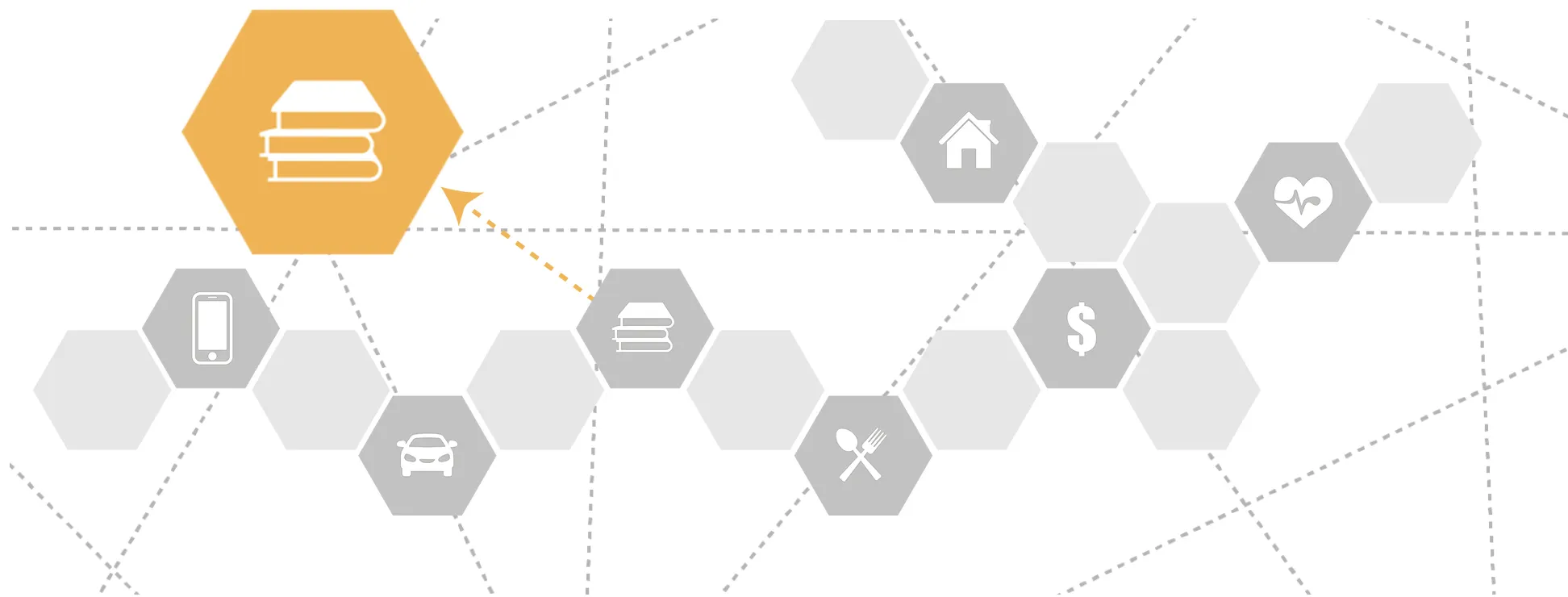
|
Housingclick to view |

|
Health Careclick to view |

|
Child Care and Educationclick to view |

|
Technologyclick to view |

|
Foodclick to view |

|
Taxesclick to view |

|
Transportationclick to view |
||
Impact on ALICE • K-12 Education
For all families, a quality K-12 education lays the groundwork for future employment opportunities and long-term economic stability. As with early education, ALICE and other low-income families face multiple barriers to access, including:
-
Income Disparities
By the time they reach high school, children from families with low socioeconomic status (SES) have literacy skills that are an average of five years behind their higher-income peers.34 Schools in communities with low SES, as well as low-SES families themselves, are more likely to have fewer resources to support students, which impacts academic achievement.35 -
The Achievement Gap
As children move on to K-12 education, the one area of concern for ALICE households is the achievement gap. Nationwide, Black, Hispanic, and Native American students (who are disproportionately low income); students with limited English proficiency; and students with disabilities have lower test scores throughout K–12 and have high school graduation rates below the national average.36 -
Housing Discrimination
Past and current public policies and an array of systemic forces — including housing discrimination — have segregated many children living in under-resourced neighborhoods with low-quality schools. Although neighborhoods and schools are modestly more integrated by race than they were decades ago, significant racial segregation persists. In most states, there is wide variation in school performance across school districts.37
What do families do if they don't live near a quality elementary, middle, or high school?
Find Alternate Means of Care
Moving to a community with higher-quality, better-performing schools is one possible solution.
Moving to a community with higher-quality, better-performing schools is one possible solution.

Housing vouchers have the potential to enable ALICE families to move to areas of opportunity, but they have not worked well in practice because many landlords will not accept them (despite this being an illegal form of housing discrimination). Most families with housing vouchers live near a school that, on average, has 74 percent low-income students and ranks in the 26th percentile by state test scores.39
Commute to a School in Another Neighborhood
While options vary by location, commuting to a higher-quality, better-performing school in another community is possible. In some areas, magnet and charter schools make this a viable option for students who meet the criteria or win the entrance lottery; in other areas, students travel just as far to attend better-performing traditional public schools. In New York City, student commuting time shows how residential segregation by race and income often determines school quality: Between 2013 and 2016, the average commuting time to the nearest high-quality school was higher for Black and low-income NYC students than for other students.40
While options vary by location, commuting to a higher-quality, better-performing school in another community is possible. In some areas, magnet and charter schools make this a viable option for students who meet the criteria or win the entrance lottery; in other areas, students travel just as far to attend better-performing traditional public schools. In New York City, student commuting time shows how residential segregation by race and income often determines school quality: Between 2013 and 2016, the average commuting time to the nearest high-quality school was higher for Black and low-income NYC students than for other students.40

Sources
34
Advisen. (2015). Safety and regulatory trends in child daycare. Retrieved from https://www.advisenltd.com/2016/01/12/safety-and-regulatory-trends-in-child-day-care/
35
American Psychological Association. (2019). Education and socioeconomic status. Retrieved from https://www.apa.org/pi/ses/resources/publications/education
Aikens, N. L., & Barbarin, O. (2008). Socioeconomic differences in reading trajectories: The contribution of family, neighborhood, and school contexts. Journal of Educational Psychology, 100(2), 235–251. Retrieved from https://psycnet.apa.org/record/2008-05694-001
36
National Center for Education Statistics. (2018). Early childhood care arrangements: Choices and costs. Retrieved from https://nces.ed.gov/programs/coe/indicator_tca.asp
Stanford Center for Education Policy Analysis. (2019). Racial and ethnic achievement gaps. Retrieved from https://cepa.stanford.edu/educational-opportunity-monitoring-project/achievement-gaps/race/
37
National Center for Education Statistics. (2018). The condition of education 2018. Retrieved from https://nces.ed.gov/pubsearch/pubsinfo.asp?pubid=2018144
U.S. Department of Housing and Urban Development. (2016). Breaking down barriers: Housing, neighborhoods, and schools of opportunity. Retrieved from https://www.huduser.gov/portal/sites/default/files/pdf/insight-4.pdf
38
U.S. Department of Housing and Urban Development. (2016). Breaking down barriers: Housing, neighborhoods, and schools of opportunity. Retrieved from https://www.huduser.gov/portal/sites/default/files/pdf/insight-4.pdf
39
U.S. Department of Housing and Urban Development. (2016). Breaking down barriers: Housing, neighborhoods, and schools of opportunity. Retrieved from https://www.huduser.gov/portal/sites/default/files/pdf/insight-4.pdf
40
Corcoran, S. P. (2018, October; revised November 2018). School choice and commuting: How far New York City students travel to school. Urban Institute. Retrieved from https://www.urban.org/sites/default/files/publication/99205/school_choice_and_commuting_3.pdf
41
U.S. Department of Housing and Urban Development. (2016). Breaking down barriers: Housing, neighborhoods, and schools of opportunity. Retrieved from https://www.huduser.gov/portal/sites/default/files/pdf/insight-4.pdf
National Center for Education Statistics. (2018). The condition of education 2018. Retrieved from https://nces.ed.gov/pubsearch/pubsinfo.asp?pubid=2018144
42
Jacobson, L. (2019, March 20). Study: Using public transit for school commute linked to higher absenteeism. Education Drive. Retrieved from https://www.educationdive.com/news/study-using-public-transit-for-school-commute-linked-to-higher-absenteeism/550735/

